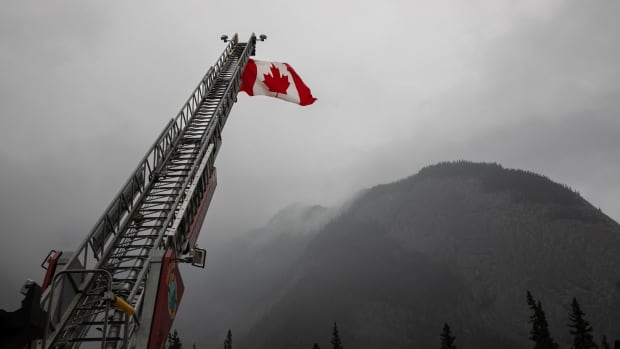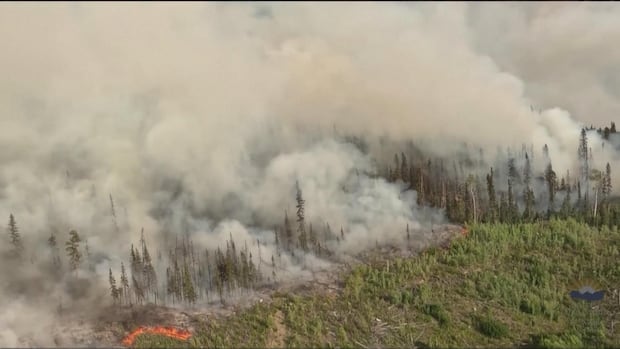
After last year’s off-the-charts, record-breaking wildfire season in 2023, this year may have felt like a reprieve — at least in some parts of the country.
But this past summer was still far above normal by several measures — and experts say what transpired holds clues for what’s to come as the climate changes, primarily due to the burning of fossil fuels.
Here’s a breakdown.
Large area burned
Given the scale of last year’s fires, this year’s wildfire season wasn’t quite as devastating.
Yet it was worse than many people realize, said Yan Boulanger, a research scientist with Natural Resources Canada.
By the numbers, the 2024 wildfire season is on track to be the second-worst wildfire season in terms of area burned since 1995, with more than 5.3 million hectares burned so far. That trails far behind last year, when more than 15 million hectares burned.
“If we are always comparing it to last year as a reference, every other year will not be as bad. But I think we have to say that it was a bad year,” Boulanger said in an interview.
The 2024 season is consistent with what wildfire scientists have observed over the past half-century — an increase, decade over decade, in the area burned, he said.
Western Canada most affected
In contrast with 2023, where much of the country had major wildfires, this year the bulk of them broke out in Western Canada.
The most costly was in Jasper, Alta., which resulted in $880 million in insured damages.
About 70 per cent of the total area burned was in British Columbia, Alberta, Northwest Territories and Saskatchewan, officials said in a briefing last week.
Dry and hot, again
Hot, dry weather is the driver of wildfires — and last year the conditions were primed for them to spread.
The map that follows shows what’s known as the Fire Weather Index (FWI), which measures the dryness of the forest (known as fuel), along with the temperature, humidity, level of precipitation and wind speed.
In 2023, this map was a dark red across nearly the whole country. While this year’s isn’t quite so dramatic, it was hotter and drier than usual, particularly in Western Canada.
“We’re finding that the depth of the drought and the areas that are under high to extreme fire danger are very large,” said Lori Daniels, a wildfire expert and University of British Columbia forestry professor.
Number of fires not increasing
The number of ignitions, also known as fire starts, was not especially high, as was the case a year earlier.
Overall, human-caused fire starts are in decline because of better awareness and stronger restrictions during peak periods of fire risk, said Daniels.
“The message about prevention, about making sure that we’re not accidentally starting fires through recreational activities or through industrial activities, that message is getting out,” Daniels said.
At the same time, she said researchers are concerned about how extreme weather could result in more “lightning outbreaks” — whereby hundreds or even thousands of lightning strikes hit in quick succession.
“When you have 100 ignitions all at once, some of those under hot, dry, windy conditions are going to become fast-moving, fire-spreading fires,” she said.
Big source of emissions
The greenhouse gas emissions produced by Canada’s wildfires last year were on a whole other level — one recent study found they produced more carbon than the burning of fossil fuels in all but three countries.
This year, Daniels said that number will be considerably lower, just as the area burned was smaller. More generally, experts have raised concern that an increasing number of larger, more intense wildfires will contribute to further climate warming.
“They’re burning deep into the soils and burning an accumulation of organic material that took literally centuries to build,” said Daniels.
“We’re emitting millions of tonnes of carbon into the atmosphere, which is again, that positive feedback with a negative consequence.”
WATCH | Last year’s wildfires emitted enough carbon to rival entire countries:
If the carbon output from Canadian wildfires in 2023 were compared to the national outputs of countries around the world, it would rank fourth behind the U.S., China and India, says NASA atmospheric scientist Brendan Byrne.
When a season doesn’t end
Climate change has contributed to earlier starts and later ends to the wildfire season, Boulanger and Daniels said.
Researchers project this trend will continue as the climate warms.
Dry conditions in northeastern B.C. could lead fires there to continue to burn through the winter once again, Daniel said. Last winter, more than 100 holdover fires smouldered underground through the winter months.
“We have some fires that ignited in 2022 and 2023 that are still burning on Oct. 1, 2024 and will still be burning in 2025,” she said.
Graphics by Wendy Martinez
